
LG C2 OLED TV Review: Early Favorite for Best High-End TV
In the last few years LG’s “C” series OLED models have risen to the top of my list as the best high-end TV for the money. The C2 is the first 2022 TV I’ve reviewed, so it’s too early to award it that crown, but so far it’s the favorite. The C2 offers image quality that’s a clear step above any non-OLED TV I’ve seen, a bigger range of sizes than ever — including a new 42-inch option — and a price that’s not too steep.
Like
- Better picture quality than any non-OLED TV
- Superior contrast and off-angle image
- Best-in-class gaming features
- Sleek styling with ultralight, thin panel
Don’t Like
- Expensive
- No major picture quality improvements over the C1 from 2021
This year, however, the OLED TV competition is tougher than ever. LG’s archrival Samsung has an OLED TV too, promising better color with an all-new QD-OLED panel. Sony offers two different kinds of OLED, including a QD-OLED of its own that looks pretty sweet in person. And in 2022 more TV-makers sell mini-LED models, which promise excellent image quality for much less money than OLED.
As is usual in the first half of the year, a new TV’s stiffest competition comes from its older self. In my side-by-side comparisons, the C2 and last year’s LG C1 OLED TV looked very similar despite the C2’s new “Evo” panel, one of the 2022 upgrades LG touts. That’s why, if you want a new high-end TV now, you should still get the C1.
Over the summer the C1 will sell out and the C2 will drop in price, making it more appealing. If you want the best price on a C2 you should hold off until fall, at which point I’ll have a much better sense of how the C2 stacks up against its rivals. It’s off to a good start though.
LG C2 sizes, series comparison
I performed a hands-on evaluation of the 65-inch OLED C1, but this review also applies to the other screen sizes in the series. All sizes have identical specs and, according to the manufacturer, should provide very similar picture quality.
- LG OLED48C1PUB, 48-inch
- LG OLED55C1PUB, 55-inch
- LG OLED65C1PUB, 65-inch
- LG OLED77C1PUB, 77-inch
- LG OLED83C1PUA, 83-inch
The C2 series sits in the middle of LG’s 2022 OLED TV lineup, with the widest range of screen sizes and all the features I expect from a high-end TV. Spending more for the G2 gets you a slightly brighter panel according to LG, as well as the wall-friendly “gallery” design. The less-expensive A2 lacks the HDMI 2.1 gaming features, 120Hz refresh rate and fancier processing found on the other 2022 LG OLEDs.
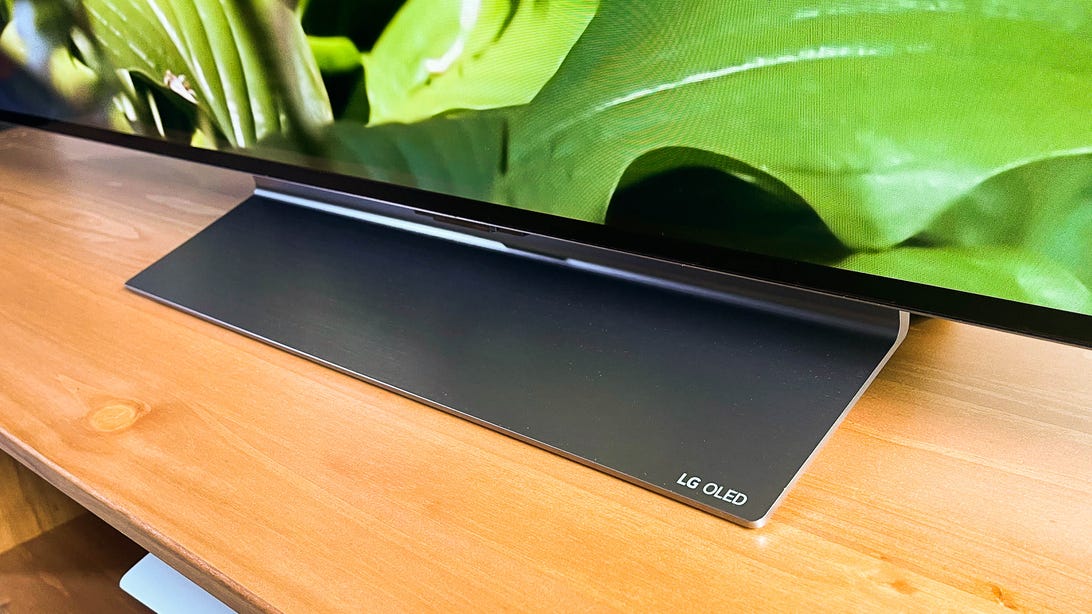
David Katzmaier/CNET
Lighter weight, nearly all picture
The C2 is a very nice-looking TV, with a minimalist appearance similar to past LG OLEDs, but the company made some changes for 2022. When a colleague and I set it up, we actually felt the first such change: it’s lighter than the C1 by a noticeable amount, up to 47 percent lighter depending on size. The 65-inch version I reviewed weighs just 37 pounds with its stand, compared to 72 pounds for the 65-inch C1.
New carbon-fiber materials are responsible for the reduced weight, according to LG, and I noticed it on the TV’s backside. The edges of the panel are slightly more squared-off as well. I also appreciated the narrower bezel, 6mm slimmer than the C1, leading to even more of an all-picture look, although if I didn’t have the two TVs side-by-side I probably wouldn’t have noticed. The stand has a much smaller footprint than last year and raises the panel a bit more over the table, both improvements in my book.
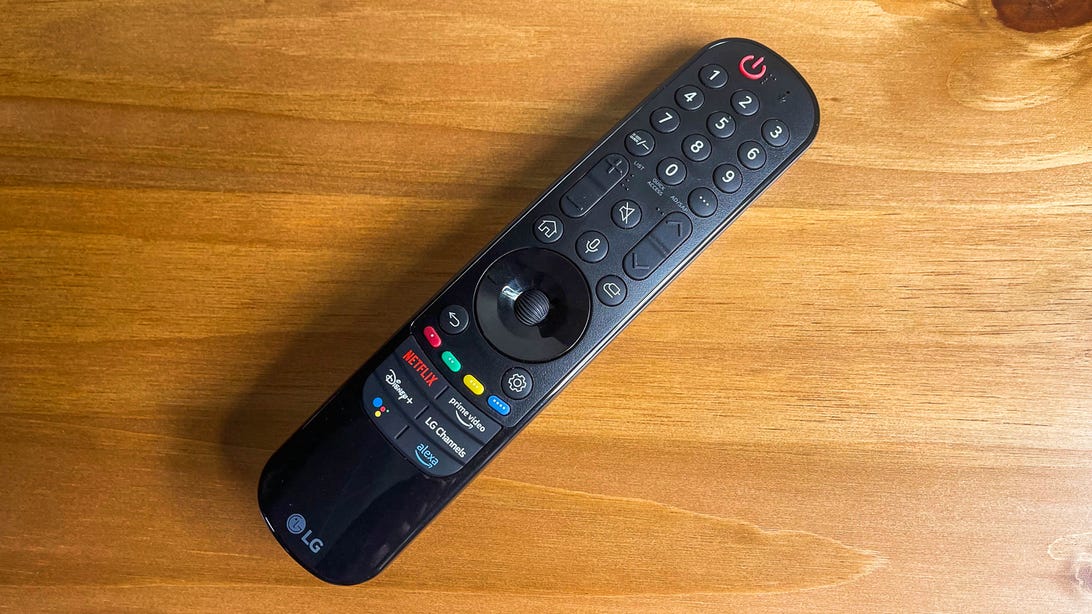
David Katzmaier/CNET
LG kept the same remote, unfortunately. In my old age I’ve grown easily annoyed by too many buttons, and I much prefer the streamlined, simple layout of Samsung and Roku/TCL remotes, for example. As always, you can wave LG’s remote around to move the cursor, or scroll quickly through menus with the built-in wheel.
Smart TV, crowded menu
LG’s WebOS menu system is not my favorite, in part because of the clutter. You’ll see notes and notifications along the top, a box that displays the weather, a prompt to sign in to LG’s system, a seemingly random collection of stuff labeled “Trending Now,” then (finally) the list of apps below. Signing in unlocks a new 2022 feature, customized recommendations and additional user accounts. LG touts the fact that you can set up favorite sports teams, for example, but most people will just go straight to the app and skip the clutter. As usual, I prefer a simpler interface like Roku, and if you like customizations and options Google TV is a better bet. On a TV this expensive you should just attach a good streaming device instead.
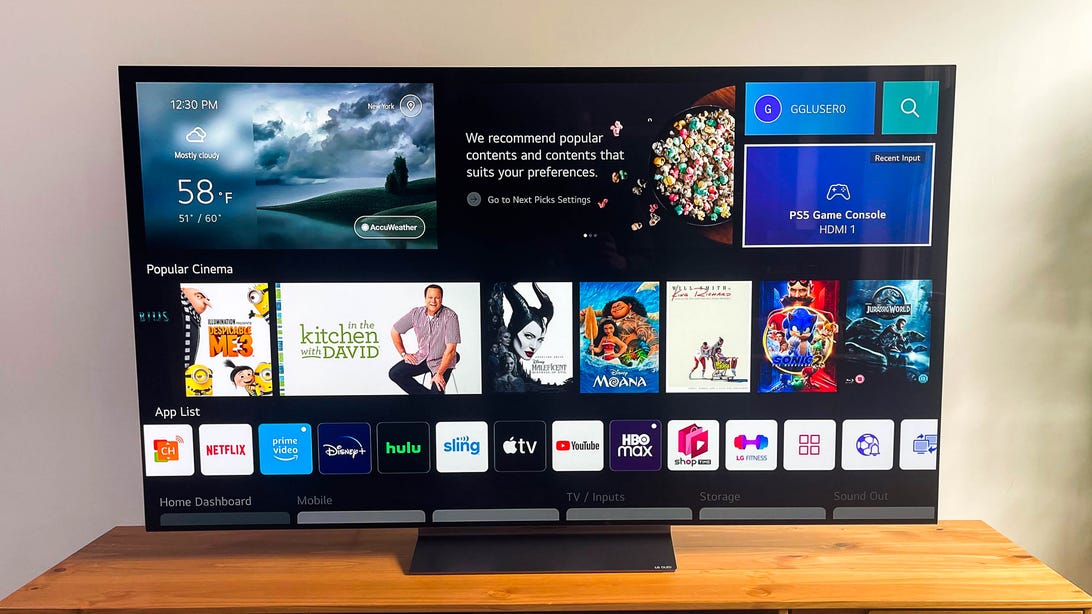
David Katzmaier/CNET
Also new for 2022 is something LG calls “always ready.” Instead of turning the screen off when you press power, the TV displays your choice of art wallpapers, a clock, “sound palette” art or your own custom photos. Designed for people who would rather have something on their big screens rather than a big black rectangle, it’s similar to the ambient mode Samsung TVs have offered for the last few years. Personally I’d rather save the power, so I’d leave this feature (and my TV) turned off.
The elements of the always-ready feature and LG’s screensaver move around so as not to risk burn-in. Here’s where I remind you that, like all OLED TVs, the C2 is more subject to both temporary and permanent image retention, aka burn-in, than LCD TVs. The risk is small, which is why I don’t consider burn-in a reason for most people to avoid buying an OLED TV. Check out our guide to OLED burn-in for more.
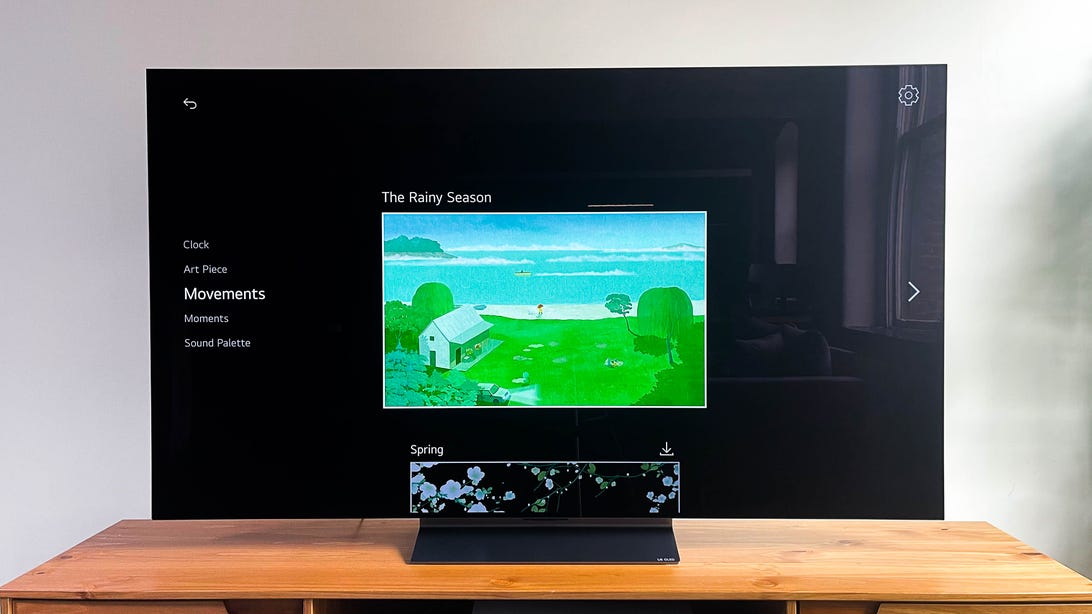
The new “always ready” feature puts something on the screen even after you turn it “off.”
David Katzmaier/CNET
LG also added a new multiview feature that puts two sources side by side or picture-in-picture, but unfortunately it’s quite limited. You can’t show two HDMI inputs on-screen and the main thing you can do — share a screen from your phone side-by-side with an input — didn’t work with Apple AirPlay. LIke most TVs, the C2 does support Apple’s phone-mirroring feature, and it also lets you issue Google Assistant or Amazon Alexa voice commands by speaking into the remote or, new for 2022, hands-free when you say the wake word like “Alexa.”
Well-connected, especially for gamers
LG continues to excel at connection options. All of LG’s 2022 OLED models (aside from the A2) include the latest version of the HDMI standard: 2.1. That means their HDMI ports can handle 4K at 120 frames per second and variable refresh rate (including Nvidia G-Sync and AMD FreeSync), as well as enhanced audio return channel and automatic low latency mode (auto game mode). In other words, they can take advantage of the latest graphics features available from PlayStation 5 and Xbox Series X and S consoles as well as high-end graphics cards. The C2 is rare among high-end TVs in that all four of its HDMI ports support 4K/120 — great for hard-core gamers with multiple next-gen devices.
- Four HDMI inputs with HDMI 2.1, HDCP 2.2
- Three USB 2.0 ports
- Optical digital audio output
- RF (antenna) input
- RS-232 port (minijack, for service only)
- Ethernet (LAN) port
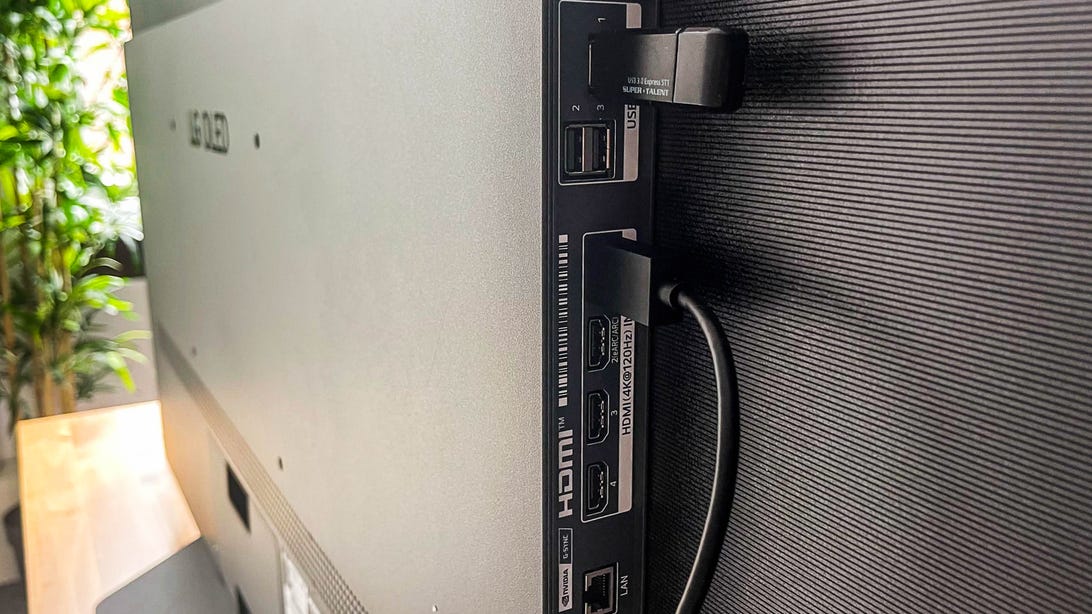
All four of the C2’s HDMI inputs support HDMI 2.1 features.
David Katzmaier/CNET
LG OLED C2 picture quality comparisons
My side-by-side comparisons involved the best TVs I had on-hand, but the only other OLED was the LG C1 from last year. Since it’s early in 2022, the C2 was the only current model-year television in the group – I’ll compare it to other 2022 TVs as soon as I get the chance. Here’s the lineup:
TV and movies: The LG C2 has a spectacular picture but watching it next to the C1 from 2021, any improvements were really tough to see. And measurements backed up my initial impressions: Both TVs delivered essentially equal numbers, and both were extremely accurate in their best modes. Both outperformed the TCL TVs in my comparison overall, as expected.
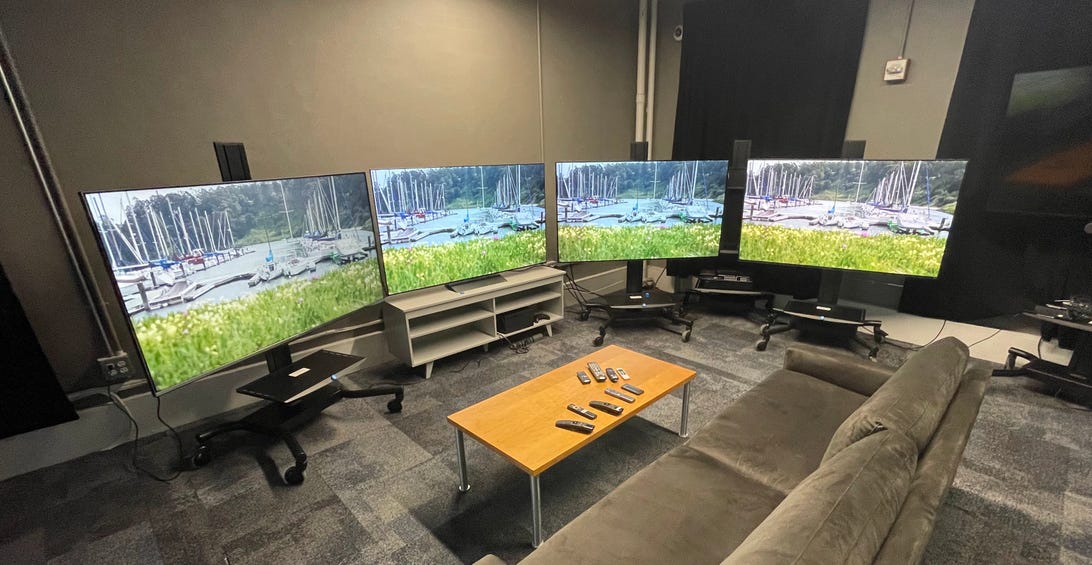
The comparison lineup with the LG C2, center, on the gray TV stand and the C1 to its right.
David Katzmaier/CNET
I started my comparison with familiar (to me) high dynamic range material, namely the demo montage from the excellent Spears & Munsil HDR benchmark 4K Blu-ray. Both OLEDs showed equally pleasing images. The perfect black levels and lack of blooming (stray illumination) in areas like the honey dripper and cityscapes created superior punch to the LCD-based TCLs. And while the snowscapes, deserts and other full-screen bright scenes from the TCL TVs outshined the OLEDs, smaller highlights in areas like the ferris wheel at night were actually brighter on the LGs. Spot measurements using a light meter revealed the C2 as being slightly brighter than the C1 on the ferris wheel, but with the naked eye I couldn’t really see the difference. I also saw more saturated, natural color on the LGs, in particular reds like the strawberries and flowers.
Switching to TV content, I put Severance from Apple TV Plus on all four sets and the results were similar. During Helly’s brain surgery in Episode 2 the dark areas looked more true and realistic on the OLEDs, without the blooming — in the letterbox bars near the operating lights, for example — I saw on the TCLs. The brightness advantage of the LCDs in the office training scene later was obvious, but the faces of Mark and Helly looked flatter and less defined. Again, however, the C1 and C2 were very difficult to tell apart.
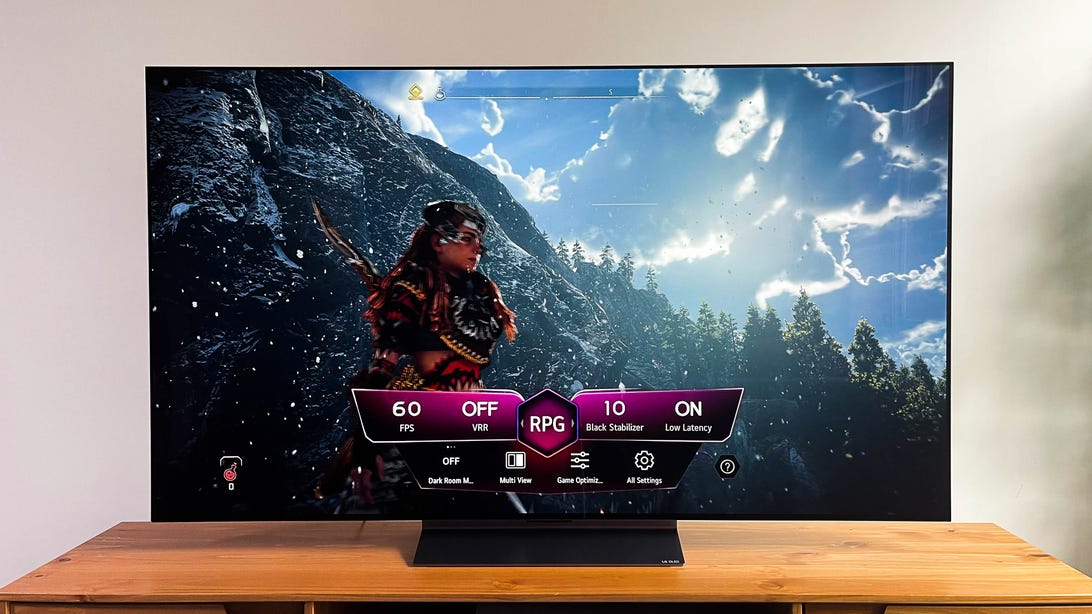
The new overlay for Game Optimizer shows vitals like frames per second and variable refresh rate, at a glance.
David Katzmaier/CNET
Gaming: As with nongaming content, the OLEDs looked better than the LCDs in my side-by-side comparisons, although the two LGs again looked very similar. The C1 was my favorite gaming TV last year, and the C2 improves it just a bit.
LG’s Game Optimizer mode offers myriad adjustments and the updated overlay menu surfaces them in a more logical way, putting VRR next to FPS and offering a few more shortcuts on the bottom, including to the new Dark Room mode. That mode dims the image and is designed to reduce eyestrain, but even though I game in the dark a lot, I don’t have much use for it. Playing Horizon Forbidden West in HDR on PS5, for example, Dark Mode made the moonlit forest less dazzling and the mountain snowscape duller, but if you’re someone who’s bothered by bright sequences in games it might be useful.
A new Sports mode joins the litany of picture modes, but as I found last year, I liked Standard best for most games with its balance of shadow detail and contrast. FPS is best if you want more visibility into shadows, or you can just crank the Black Stabilizer control up (at the expense of a washed-out image). I appreciate the separate adjustments just for gaming, which most other TV makers don’t have.
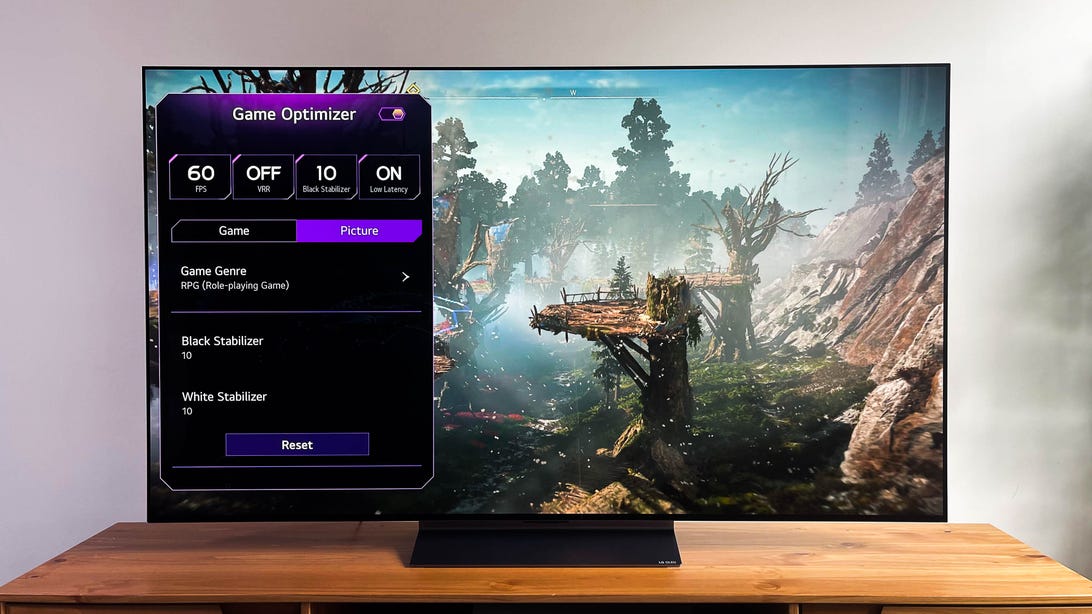
The full Game Optimizer menu shows even more options.
David Katzmaier/CNET
Buried within Game Optimizer is another setting labeled “Reduce input delay (input lag)” with two options, Standard and Boost. The former, which is the default for any game, serves up an excellent input lag result similar to past LG OLED models: just 13.5ms for both 1080p and 4K HDR sources. Engaging Boost cuts lag even further, to just under 10ms for both. The catch is that Boost is only available for 60Hz sources, so you can’t use it with 120Hz games or VRR. And no, I don’t think many humans would notice the extra 3ms of lag.
Bright lighting: Although LG touts the C2 as 20% brighter than non-Evo OLED TVs like the C1, my measurements didn’t back that claim up. Yes the C2 was a bit brighter, about seven percent on average, but the difference wasn’t visible in just about anything I watched. In my experience those differences are slight enough to vary from sample to sample.
Below are my measurements in nits for select comparison TVs in their brightest and most accurate picture modes, using both standard dynamic range (SDR) and high dynamic range (HDR) test patterns.
Light output in nits
| TV | Brightest mode (SDR) | Accurate mode (SDR) | Brightest mode (HDR) | Accurate mode (HDR) |
|---|---|---|---|---|
| Hisense 65U8G | 1,619 | 1,612 | 2,288 | 2,288 |
| Samsung QN65QN90A | 1,622 | 1,283 | 2,596 | 1,597 |
| TCL 65R635 | 1,114 | 792 | 1,292 | 1,102 |
| Sony XR65X90J | 951 | 815 | 945 | 847 |
| LG OLED65C2 | 413 | 389 | 812 | 759 |
| LG OLED65C1 | 409 | 333 | 790 | 719 |
The C2 is plenty bright enough for just about any viewing environment, but as usual it’s not nearly as bright as competing LCD-based models. As with most TVs, the brightest mode for HDR and SDR (Vivid on the C2) is horribly inaccurate. For the accurate results listed above on the C2, I used ISF Expert Bright picture mode (Peak Brightness: High) for SDR and Filmmaker mode for HDR. I recommend C2 owners do the same to get good color in bright rooms. Note that with SDR, you’ll need to disable the Auto Energy Saving setting (Support > Energy Saving > Energy Saving Step > Off) to get full brightness.
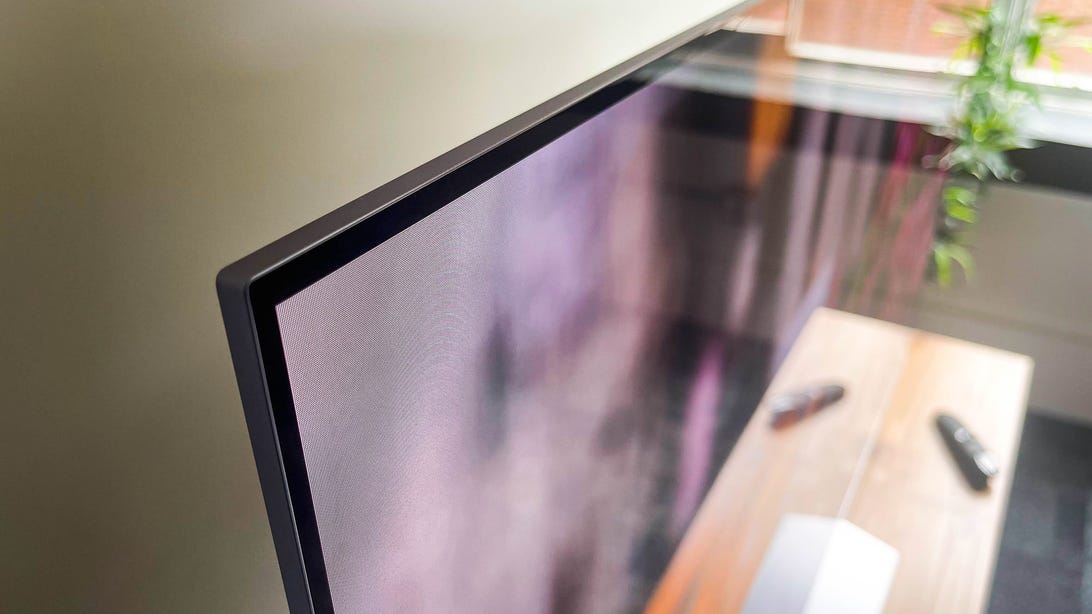
The screen of the C2 was excellent from off-angle but didn’t seem to reduce reflections quite as well as the C1.
David Katzmaier/CNET
Like all OLED TVs, the C2 gets quite a bit dimmer than LCDs when showing full-screen white — a snow field, for example — but even in those situations it’s hardly dim. The C2’s screen finish was excellent at preserving black levels, better than the TCLs’ more matte finishes, which beat both LG’s at rejecting reflections. The screen of the C1 seemed slightly more reflective than the C2, but the difference was minimal.
Uniformity and viewing angle: Like all OLEDs I’ve tested the C2 was exemplary in this area compared to LCD-based TVs, with no significant brightness or color variations across the screen and nearly perfect image quality from off-angle. Comparing the C2 and C1 I saw a very slight color shift toward blue and magenta on the C2 that wasn’t visible on the C1, something that could be caused by the new Evo panel structure. It was only visible from very extreme angles, however, and has no real impact.
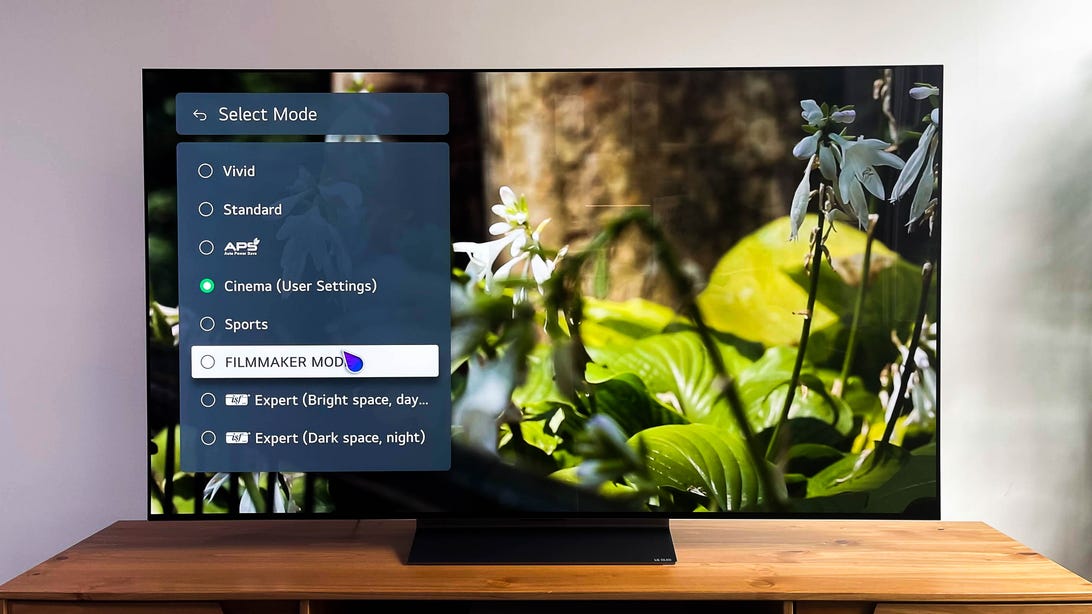
The C2 has myriad picture settings, but if you just want to set it and forget it, use Filmmaker Mode.
David Katzmaier/CNET
Picture setting notes
The most accurate settings were Cinema and Filmmaker mode for both HDR and SDR, as well as the two ISF modes available in SDR. For SDR viewing I went with Cinema for dark rooms (because it was closer to my 2.2 gamma target) and ISF Bright for brighter environments, and for HDR I used Filmmaker (which was very slightly brighter than Cinema HDR). Game Optimizer is best for gaming, thanks to its processing, but quite blue; for the best color accuracy for gaming you should adjust the color temperature control all the way toward red (Picture > Advanced Settings > Color > White Balance > Color temperature > Warm50).
Like most TVs the C2 offers settings that engage smoothing, aka the soap opera effect, as I prefer to turn it off for TV shows and movies (and it’s off in Game Optimizer mode because it increases input lag). You can experiment with the settings (Picture > Advanced Settings > Clarity > TruMotion) and it’s off by default in the Cinema and Filmmaker modes.
Geek box
| SDR | Result | Score |
|---|---|---|
| Black luminance (0%) | 0.000 | Good |
| Peak white luminance (10% win) | 389 | Average |
| Avg. gamma (10-100%) | 2.16 | Good |
| Avg. grayscale error (10-100%) | 1.34 | Good |
| Dark gray error (30%) | 0.67 | Good |
| Bright gray error (80%) | 1.66 | Good |
| Avg. color checker error | 0.95 | Good |
| Avg. saturation sweeps error | 1.00 | Good |
| Avg. color error | 0.81 | Good |
| Input lag (Game mode) | 13.47 | Good |
| HDR10 | ||
| Black luminance (0%) | 0.000 | Good |
| Peak white luminance (10% win) | 759 | Average |
| Gamut % UHDA/P3 (CIE 1976) | 99.62 | Good |
| ColorMatch HDR error | 5.93 | Poor |
| Avg. color checker error | 2.94 | Good |
| Input lag (Game mode, 4K HDR) | 13.47 | Good |
See How We Test TVs for more details.
Portrait Displays Calman calibration software was used in this review.
